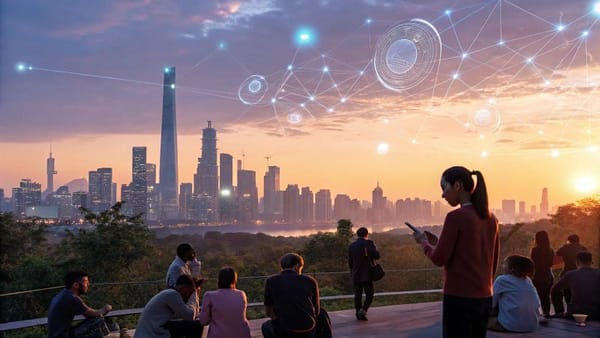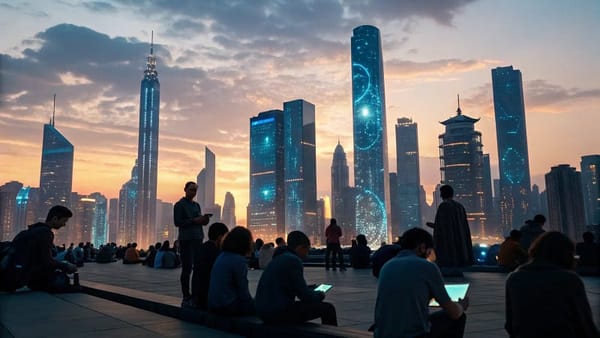Will AI Destroy Our Ability to Read and Write?
I still remember running wild in the local library as a kid, lost between rows of books — and, honestly, spending way too long getting the…

I still remember running wild in the local library as a kid, lost between rows of books — and, honestly, spending way too long getting the perfect sci-fi novel for the week. Fast forward to now, and the world I imagined in those pages is starting to catch up, in the strangest ways. If you’ve noticed you don’t reach for a book as much as you start YouTube, TikTok, or even fire off a quick voice note, you’re not alone. The march of progress is relentless, and, wild as it sounds, the next chapters in human communication might just make reading and writing as quaint as cave drawings. Let’s see if you’re ready for a world where ‘text’ is as retro as a beeper.
From Scrolls to Streams: The Future of Communication
Reading and writing have been the backbone of historical text communication for thousands of years. Yet, as history shows, even the most deeply embedded technologies eventually give way to new forms. The journey of text — from an exclusive tool for the elite to a daily staple for billions — has been remarkable. But today, communication technology trends are shifting rapidly, and the future of communication is being shaped by forces that are faster, louder, and undeniably stranger.
Long before the first alphabet appeared around 1500 BC, humans relied on oral storytelling to share knowledge and preserve culture. The invention of writing systems was a breakthrough, compressing complex ideas into symbols that could travel across time and space. For centuries, literacy was a privilege, reserved for a select few who could access scrolls or carved tablets. That changed dramatically in 1440, when Gutenberg’s printing press democratized text, making books and newspapers available to a much wider audience. Still, it wasn’t until the mid-20th century that reading became a truly mass practice, woven into the fabric of everyday life.
But nothing stays forever. While text remains essential, it is now losing ground to dynamic media. The internet, with its digital forums and blogs, transformed information from something fixed and curated to something fluid and ever-changing. Suddenly, content was not just more abundant — it was fundamentally different. As one observer put it,
I loved disappearing into these worlds that were different than the physical world around me.
That sense of discovery, once found in quiet libraries, now lives in the wild, unpredictable spaces of online communities.
This shift is not just about quantity; it’s about the nature of content itself. Books and newspapers offered a one-way street — readers consumed what publishers provided. In contrast, digital platforms encourage participation, remixing, and conversation. The rise of audio, video, and interactive formats is accelerating this change. Research shows that short-form video content, for example, is now preferred for learning and engagement, with higher completion rates and more effective audience capture than traditional text.
Communication technology trends like AI, 5G, and immersive media are pushing the boundaries even further. AI-driven tools are making it possible for anyone to create sophisticated video and audio content, while augmented reality (AR) and virtual reality (VR) promise experiences that are both interactive and deeply personal. The historical evolution of text communication is being complemented — and sometimes replaced — by these multimedia and AI-driven formats. As a result, there is a clear cultural shift from reading to watching and listening, with new generations embracing faster, more engaging ways to connect and learn.
It’s tempting to think that reading and writing will always have a place. And perhaps they will, but the evidence suggests that the future of communication will be defined by speed, interactivity, and a willingness to embrace the weird and wonderful possibilities of new technology. The story of communication is still being written, but it’s clear that the next chapter will look very different from the last.
AI, Avatars, and the Vanishing Line Between Creator and Consumer
The line between content creator and consumer is blurring at an astonishing pace, thanks to the rise of AI video avatars and the ongoing AI democratization of content creation. What once required a full production crew and a Hollywood budget can now be accomplished in a bedroom — or, as some have discovered, by accident during lunch. AI-powered video creation is no longer a futuristic fantasy; it’s a present-day reality, and it’s changing who gets to tell stories, teach, and communicate on a global scale.
Consider the case of Synthesia, a leader in neural networks video production. Their AI avatars now teach, train, and sell in over 130 languages, reaching millions of people every day. These digital humans don’t just mimic human speech — they capture emotional nuance and naturalness, making it increasingly difficult to distinguish between a real person and their AI-generated counterpart. As one industry expert put it:
AI can create highly photorealistic content digitally. Computers can learn what the world looks like, and they can replicate it and remix it in amazing details.
This isn’t just about entertainment. AI in communication is revolutionizing education, workplace training, and customer experience across cultures and languages. AI avatars are onboarding new employees at restaurants, providing health guidance, and even teaching school subjects — without ever needing a camera or a studio. The barriers to entry are falling away. No expensive equipment. No technical expertise required. Just imagination and a willingness to experiment.
Research shows that this shift is more than a novelty. In a recent study conducted with over 400 participants, 77% said they preferred learning through video rather than text. This preference is driving a cultural shift toward video-first communication, with AI-generated content quickly overtaking traditional formats for both learning and engagement. The ability to personalize content at scale — delivering it in the learner’s native language, with a familiar face — makes AI video avatars an incredibly powerful tool for global communication.
But there’s an uncanny side to this new era. Building your own avatar can feel both exhilarating and unsettling. There’s a certain thrill in seeing a digital twin of yourself come to life, speaking with your voice, moving with your mannerisms. And yet, it’s a little weird — almost like seeing a version of yourself you never signed up for. This blurring of authenticity is part of what makes AI avatars so compelling, and so disruptive.
The democratization of AI video production is empowering millions of new creators. At Synthesia alone, over a million people have already become video creators, producing everything from onboarding tutorials to product demos — often without asking for permission or waiting for approval. The tools are simple, the results are stunning, and the implications are profound. As AI-generated content becomes more natural and expressive, the distinction between creator and consumer continues to vanish.
When Video Eats the Written Word: Why We’re Hooked (Guilt and All)
It’s hard to ignore the seismic shift in how people consume information today. Short-form videos and podcasts have rapidly become the go-to sources for learning, entertainment, and even news. Platforms like TikTok, once dismissed as a fleeting trend, are now not only the fastest-growing social networks but also top search engines. Video consumption trends show that digital media is now dominated by video and audio, with users gravitating toward formats that deliver instant answers and rich experiences.
There’s a certain irony in this transformation. Many still feel a lingering sense of guilt — call it “Netflix over novels” syndrome. Even those who love reading admit to finishing more streaming series than books in the past year. The old-school belief that books are somehow morally superior persists, even as our habits change. Why is that? Perhaps it’s a holdover from a time when dense, slow information was the only option. Today, as one observer puts it,
What if we’re all just tired of overly dense, slow information? Books with too many pages, newspaper articles with filler.
The truth is, people are developing sharper taste and higher standards for content. With infinite choice at their fingertips, audiences are less willing to slog through long texts when a short-form video or podcast can deliver the same insights in minutes. Research shows that these formats have significantly higher completion and engagement rates than traditional long-form content. It’s not just about attention spans — though those are changing, too. It’s about efficiency and value. Why spend hours reading a 200-page book on music theory when a YouTube video can demonstrate the basics, complete with audio, in under ten minutes?
This isn’t just a generational quirk. It’s a response to the way technology has rewired our learning habits. Interactive learning experiences — from video tutorials to podcasts — fit seamlessly into busy lives. Whether it’s listening to the news during a commute or watching product demos before making a purchase, video and audio are everywhere. Even our communication has shifted: voice notes on WhatsApp, video messages, and social media stories have replaced much of the written word.
Of course, there’s an economic side to this story. Until recently, producing high-quality video content was expensive and time-consuming. But the rise of AI-generated content is changing the equation. AI tools now make it practical for anyone to create engaging, personalized, and scalable media. This democratization of content means that high-quality video is no longer reserved for big brands or media companies. Anyone with a smartphone and an idea can reach a global audience.
As video consumption trends accelerate, the cultural shift is unmistakable. The written word still matters, but it’s being reimagined and, in many cases, complemented — or even replaced — by richer, faster, and sometimes weirder forms of communication. The guilt may linger, but the reality is clear: the future of learning and connection is short, loud, and interactive.
Into the Rabbit Hole: Ethics, Weirdness, and the Next Layer of AI Experiences
Step into your inbox. Now imagine it’s filled with video avatars — some teaching, some selling, some just chatting. Or picture learning algebra from your favorite celebrity’s digital twin, their voice and face rendered so perfectly you forget it’s not really them. This is not science fiction; it’s the new frontier of AI in communication, where boundaries between what’s real and what’s generated are blurring at a pace that’s hard to track.
The rise of augmented reality applications and virtual reality technology is pushing us deeper into immersive experiences. Meetings in VR can feel so authentic, so emotionally charged, that you might forget who’s human and who’s not. Research shows that these technologies are already redefining how we learn, connect, and even form memories. AI avatars today provide guidance, teach, and sell in more than 130 languages daily. In the near future, these digital personas may become indistinguishable from reality, raising profound questions about authenticity and trust.
But as the technology accelerates, so do the ethical and design dilemmas. Who owns your digital likeness? What does it mean for privacy when an AI can mimic your voice, your gestures, even your sense of humor? Would you trust a digital clone to deliver difficult news, or would you still want a human touch? The questions are multiplying faster than the answers.
Do you care if our content is A.I. Generated or not? Do you care when a film uses special effects or green screen?
These questions, once reserved for film buffs debating special effects, now sit at the heart of everyday digital life. Does it matter if the person on your screen is real or generated? Can you feel genuine empathy for an AI, or does the knowledge of its artificiality create a barrier? The social implications of AI content are vast and unpredictable. Some will embrace the weirdness, finding new ways to connect and learn. Others may recoil, wary of losing touch with what’s authentic.
Meanwhile, the emergence of interactive, never-ending media streams — think TikTok feeds or AI-driven series — means we’re consuming more content, faster and louder than ever. The cultural shift toward video over text is accelerating, driven by a desire for engagement and immediacy. As AI democratizes content creation, anyone can produce high-quality, personalized media, but the line between creator and consumer, real and artificial, continues to blur.
Ultimately, the next layer of AI experiences is as much about ethics as it is about technology. Ethics in AI entertainment will shape not only what we see and hear, but how we trust, feel, and remember. The rabbit hole is deep, and we’re only just beginning to explore its twists and turns. Whether this new era leads to greater empathy or just more chaos remains to be seen — but one thing is certain: the future of immersive experiences will challenge our notions of reality in ways we’re only starting to imagine.
TL;DR: Written words won’t disappear overnight, but they’re standing on a narrowing ledge. The real action is happening in AI-generated video, interactive learning, and personalized content — get used to experiencing, not just reading, your next big idea.
Hats off to TED.com for the thought-provoking content!




